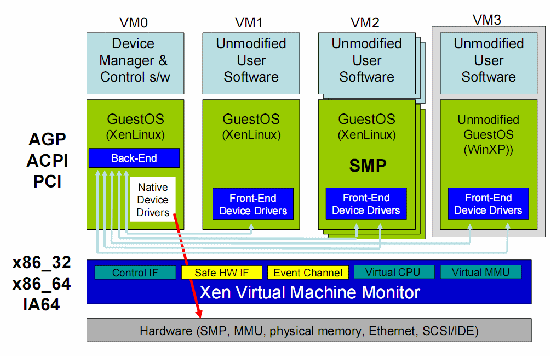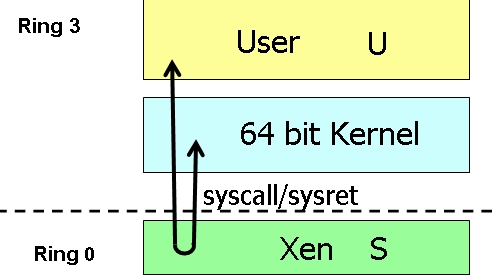Hardware Virtualization: the Nuts and Bolts
by Johan De Gelas on March 17, 2008 3:00 AM EST- Posted in
- IT Computing
Paravirtualization
Paravirtualization is not that different from Binary Translation. BT changes "critical" or "dangerous" code into harmless code on the fly; paravirtualization does the same thing, but in the source code. Of course, changing the source code allows a bit more flexibility than changing everything on the fly, which has to happen quickly. One advantage is that paravirtualization eliminates a lot of unnecessary "traps" by the VMM (or Hypervisor), even more than BT.
The hypervisor provides hypercall interfaces for critical kernel operations such as memory management, interrupt handling, and time keeping. These hypercalls will only happen when it is necessary. For example, most of the memory management is done by the different guest OSes. The Hypervisor will only be "called" for things like page table updates and DMA accesses.

Simplified front end drivers interface to "normal" Linux backend drivers.
The best feature of the Xen implementation of virtualization is the way I/O is handled. I/O devices in the VM are just simplified interfaces that link to real native drivers in a privileged VM (called Domain 0 in Xen). This means there is no emulation involved, and the overhead is significantly reduced. That this is more than Xen propaganda is illustrated by VMware ESX: while VMs running on early ESX versions had rather low network performance, VMs running on ESX 3.x have very acceptable network performance thanks to a cleverly implemented paravirtualized vmxnet network driver.
To resume, paravirtualization is an excellent concept, as you eliminate (binary) translation overhead completely, I/O driver overhead significantly, and system call overhead somewhat. Very frequent interrupts and system calls can still cause overhead. We'll study Xen in more detail in later articles. The biggest disadvantages are:
- You
cannot use unmodified OS guests (if you use paravirtualization only)
- 64-bit guests have to run in a non-privileged ring (ring 3). [6]

Software paravirtualization doesn't handle 64-bit OSes very well.
The second problem might not seem like a big problem, but in order to protect the OS, page table switching is necessary. This results in two system calls and a TLB flush, which is very costly. Let us see what Intel's VT-x and AMD-V can offer us.










2 Comments
View All Comments
toony - Tuesday, March 20, 2012 - link
could you give me a analysis about EPT tech in detail or introduce me some reference about it? thx a lot...RogerAlvarado - Tuesday, August 3, 2021 - link
A deep shows changing for the approval of the phases for the field. The reforms of the https://softwaretested.com/technology/six-ways-sof... are met for the options. The theme is argued for the mid of the final mode for all affairs and activities for the visitors of the posts.